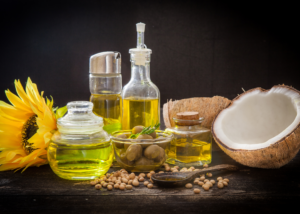Which Oils to Use for What?
 Cooking oils are some of the best sources of fat in the diet. Fat is required by the body for a variety of reasons, including hormone regulation, keeping nails, skin, and hair healthy and strong, and is required for the absorption of fat-soluble vitamins (vitamins A, D, E, and K). There are a variety of different fats found in oils. You may have heard of heart healthy fats, or unsaturated fats, that come as both poly- and mono-unsaturated fats. On the other hand, saturated fats don’t have many health benefits but can still be part of a balanced diet. Trans fats should be avoided as much as possible given the negative impact on health.
Cooking oils are some of the best sources of fat in the diet. Fat is required by the body for a variety of reasons, including hormone regulation, keeping nails, skin, and hair healthy and strong, and is required for the absorption of fat-soluble vitamins (vitamins A, D, E, and K). There are a variety of different fats found in oils. You may have heard of heart healthy fats, or unsaturated fats, that come as both poly- and mono-unsaturated fats. On the other hand, saturated fats don’t have many health benefits but can still be part of a balanced diet. Trans fats should be avoided as much as possible given the negative impact on health.
You may be overwhelmed by the wide variety of cooking oils available on the shelves at the grocery store. This variety exists for a few reasons. Some oils may help bring out the flavor of certain foods, baking may require different oils to get the right texture, and oils used for cooking on the stove have different “smoke points”. Oils contain different ratios of types of fat and antioxidants which react to temperatures and environments differently. The smoke point is the temperature at which a fat begins to smoke or burn. A high smoke point is 400 degrees F or higher, meaning that it can withstand higher temperatures before it begins to smoke. A low smoke point is anything that begins to burn below 225 degrees F, which are oils that should not be used for cooking on a stovetop as they will likely lead to burning.
Let’s talk about a few different types of cooking oils.
The most common oil used for cooking is olive oil. Olive oil comes in different varieties based on the level of processing, but overall, olive oil is high in monounsaturated fats which have beneficial effects on heart health. Regular or light olive oil can be used for pan frying or searing due to its high smoke point. Extra virgin olive oil has a low smoke point so should only be used to cook foods at low heat or as a topping like for salad dressing.
Canola oil is another commonly used cooking oil. Canola oil has a similar make up to olive oil, is high in monounsaturated fats, and low in saturated fats. Canola oil has a subtle flavor and a high smoke point, both of which make canola oil a very versatile oil. Use canola oil for stir-frying, sauteing, grilling, baking, or in sauces and dressings.
Peanut oil is higher in saturated fat than canola or olive oils but is still high in monounsaturated fats. Peanut oil has a slightly nutty flavor, and a high smoke point so is great for frying or stir-frying.
Avocado oil sometimes has a reputation of being “healthier” than other oils. In truth, the content is similar to that of olive and canola oil, high in monounsaturated fats. Avocado oil does have a very high smoke point though, higher than most other cooking oils, which is great for roasting, pan-frying, barbequing, and can also be used in baking.
Sunflower and safflower oil are different than other oils discussed so far since they are high in polyunsaturated fats. While polyunsaturated fats are still considered heart healthy, the particular polyunsaturated fat that these oils are high in are omega 6 fats. Omega 6 and omega 3s compete with each other in the body and too much omega 6 vs. omega 3 may have an inflammatory effect. These oils have a high smoke point so can be used for deep frying and roasting.
Coconut oil is also different than other oils because its makeup is largely saturated fat. Coconut oil can be good to use in baking as a plant-based replacement for butter since it’s solid at room temperature. It has a medium smoke point; about 350 degrees. It can also be used in other dishes but does have a strong coconut flavor. Coconut oil is extremely versatile though as it can be used in skincare and hair products too!
Although not an oil, butter is another type of fat used for cooking or as a topping for many dishes. Although very tasty, butter is made up largely of saturated fats (similar to coconut oil) and is often high in sodium. Butter can be part of a balanced diet if used in moderation, but to increase your intake of heart healthy fats, try swapping out butter for oil when cooking.
There are plenty of other oils available on the market and coming onto the market. Overall, all oils are made up of different ratios of types of fats that are required by the body. The most important thing to keep in mind before selecting an oil is what you might be using the oil for and the smoke point, so you don’t accidentally cause a cloud of smoke in your kitchen. Oils also have different tastes and flavors so do a taste test and see which your taste buds prefer! You can do this by dipping a piece of bread into different oils.
- Dietitian Reuby

